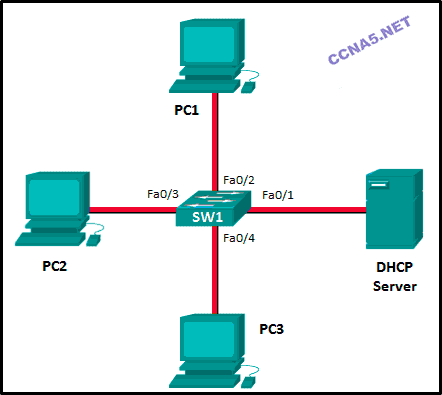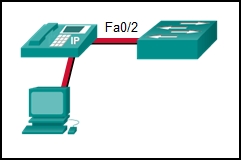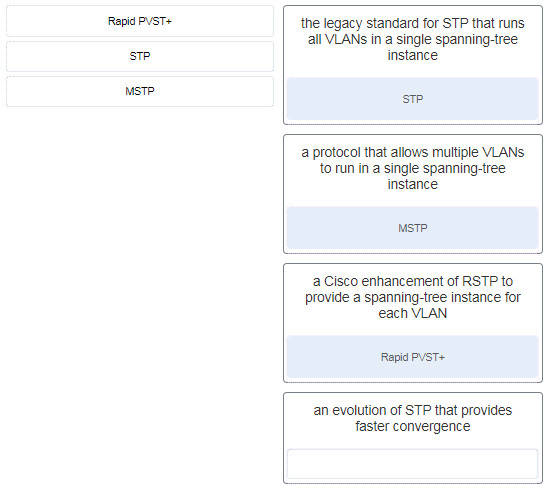CCNA2 v6.0 Chapter 4 Exam Answers
1. A network designer must provide a rationale to a customer for a design which will move an enterprise from a flat network topology to a hierarchical network topology. Which two features of the hierarchical design make it the better choice? (Choose two.)
lower bandwidth requirements
reduced cost for equipment and user training
easier to provide redundant links to ensure higher availability*
less required equipment to provide the same performance levels
simpler deployment for additional switch equipment*
2. What is a collapsed core in a network design?
a combination of the functionality of the access and distribution layers
a combination of the functionality of the distribution and core layers*
a combination of the functionality of the access and core layers
a combination of the functionality of the access, distribution, and core layers
3. What is a definition of a two-tier LAN network design?
access and core layers collapsed into one tier, and the distribution layer on a separate tier
access and distribution layers collapsed into one tier, and the core layer on a separate tier
distribution and core layers collapsed into one tier, and the access layer on a separate tier*
access, distribution, and core layers collapsed into one tier, with a separate backbone layer
4. What is a basic function of the Cisco Borderless Architecture distribution layer?
acting as a backbone
aggregating all the campus blocks
aggregating Layer 3 routing boundaries*
providing access to end user devices
5. Which two previously independent technologies should a network administrator attempt to combine after choosing to upgrade to a converged network infrastructure? (Choose two.)
user data traffic*
VoIP phone traffic*
scanners and printers
mobile cell phone traffic
electrical system
6. A local law firm is redesigning the company network so that all 20 employees can be connected to a LAN and to the Internet. The law firm would prefer a low cost and easy solution for the project. What type of switch should be selected?
fixed configuration*
modular configuration
stackable configuration
StackPower
StackWise
7. What are two advantages of modular switches over fixed-configuration switches? (Choose two.)
lower cost per switch
increased scalability*
lower forwarding rates
need for fewer power outlets*
availability of multiple ports for bandwidth aggregation
8. Which type of address does a switch use to build the MAC address table?
destination IP address
source IP address
destination MAC address
source MAC address*
9. Which network device can be used to eliminate collisions on an Ethernet network?
firewall
hub
router
switch*
10. What two criteria are used by a Cisco LAN switch to decide how to forward Ethernet frames? (Choose two.)
path cost
egress port
ingress port*
destination IP address
destination MAC address*
11. Refer to the exhibit. Consider that the main power has just been restored. PC3 issues a broadcast IPv4 DHCP request. To which port will SW1 forward this request?

to Fa0/1 only
to Fa0/1 and Fa0/2 only
to Fa0/1, Fa0/2, and Fa0/3 only*
to Fa0/1, Fa0/2, Fa0/3, and Fa0/4
to Fa0/1, Fa0/2, and Fa0/4 only
12. What is one function of a Layer 2 switch?
forwards data based on logical addressing
duplicates the electrical signal of each frame to every port
learns the port assigned to a host by examining the destination MAC address
determines which interface is used to forward a frame based on the destination MAC address*
13. Refer to the exhibit. How is a frame sent from PCA forwarded to PCC if the MAC address table on switch SW1 is empty?

SW1 floods the frame on all ports on the switch, excluding the interconnected port to switch SW2 and the port through which the frame entered the switch.
SW1 floods the frame on all ports on SW1, excluding the port through which the frame entered the switch.*
SW1 forwards the frame directly to SW2. SW2 floods the frame to all ports connected to SW2, excluding the port through which the frame entered the switch.
SW1 drops the frame because it does not know the destination MAC address.
14. A small publishing company has a network design such that when a broadcast is sent on the LAN, 200 devices receive the transmitted broadcast. How can the network administrator reduce the number of devices that receive broadcast traffic?
Add more switches so that fewer devices are on a particular switch.
Replace the switches with switches that have more ports per switch. This will allow more devices on a particular switch.
Segment the LAN into smaller LANs and route between them.*
Replace at least half of the switches with hubs to reduce the size of the broadcast domain.
15. Refer to the exhibit. How many broadcast domains are displayed?
1
4
8*
16
55
16. Which solution would help a college alleviate network congestion due to collisions?
a firewall that connects to two Internet providers
a high port density switch*
a router with two Ethernet ports
a router with three Ethernet ports
17. Which network device can serve as a boundary to divide a Layer 2 broadcast domain?
router*
Ethernet bridge
Ethernet hub
access point
18. What is the destination address in the header of a broadcast frame?
0.0.0.0
255.255.255.255
11-11-11-11-11-11
FF-FF-FF-FF-FF-FF*
19. Which statement describes a result after multiple Cisco LAN switches are interconnected?
The broadcast domain expands to all switches.*
One collision domain exists per switch.
Frame collisions increase on the segments connecting the switches.
There is one broadcast domain and one collision domain per switch.
20. What does the term “port density” represent for an Ethernet switch?
the memory space that is allocated to each switch port
the number of available ports*
the numbers of hosts that are connected to each switch port
the speed of each port
21. What are two reasons a network administrator would segment a network with a Layer 2 switch? (Choose two.)
to create fewer collision domains
to enhance user bandwidth*
to create more broadcast domains
to eliminate virtual circuits
to isolate traffic between segments*
to isolate ARP request messages from the rest of the network
22. Fill in the blank.
A converged network is one that uses the same infrastructure to carry voice, data, and video signals.
23. Match the borderless switched network guideline description to the principle. (Not all options are used.)
Place the options in the following order:
allows intelligent traffic load sharing by using all network resources -> flexibility
facilitates understanding the role of each device at every tier, simplifies deployment, operation, management, and reduces fault domains at every tier -> hierarchical
allows seamless network expansion and integrated service enablement on an on-demand basis -> modularity
satisfies user expectations for keeping the network always on -> resiliency

